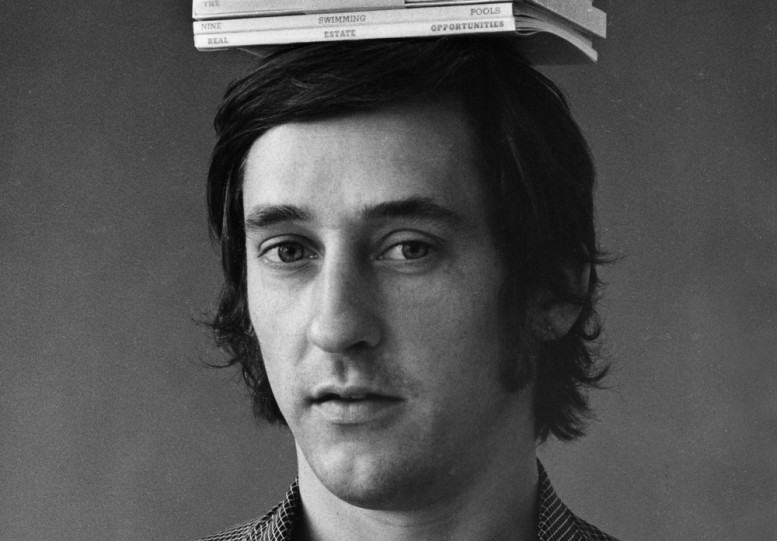Galerie Christophe Gaillard hosts “Unique in Their Genders” (“Uniques en leur genres”). This group show is a kind of “other world” in which self-eroticism, personality games and domestic space are theatre for the most intimate and unconfessed fantasies. In these (art) rooms, all variations are not only conceivable: they exist. Roles, then, aren’t as set as they are on the outside and in the shadowy light of a gallery that resembles to a domestic space, reality can reflect many surprises. On view until December 17 at Galerie Christophe Gaillard in Paris. photographs by Mazzy-Mae Green
Stand Still Like a Hummingbird
 Jerry McMillan, Ed Ruscha with six of his books on his head, 1970
Jerry McMillan, Ed Ruscha with six of his books on his head, 1970
David Zwirner gallery in New York presents Stand Still like the Hummingbird, an exhibition curated by Bellatrix Hubert in the gallery’s 525 and 533 spaces. It takes its title from a collection of short stories and essays by American writer Henry Miller, published in 1962. Known equally for his mysticism and dark humor, Miller proposed the idea of “flying backwards, standing still like a hummingbird” as a lighthearted antidote to the frantic pace of modern society. The exhibition also embraces the paradox in the appropriation of its title – the hummingbird only appears still because of the rapidity of its wings – and gathers a selection of paintings, sculptures, and videos by artists who engage with contradictions, impossibilities, and the absurd. The exhibition also explores the notion of "understated gestures and formal restraint" - finding its historical starting point in Marcel Duchamp's Comb and other readymades artworks that came to influence a century of art making. Works in the show include Forty-two postcards by On Kawara, stamped by the time he got up on a given day and simply titled I Got Up(1968-1976), a collection of Ed Ruscha’s photobooks (1964-1978), works by Bernd and Hilla Becher, Francis Alÿs, Marcel Duchamp, and more. Stand Still Like a Hummingbird will be on view from June 28 to August 3, 2012 at David Zwirner gallery, 525 West 19th Street, New York.
Thomas Ruff's Nudes
In 2003 Ruff produced the first nudes, culling images from internet pornography, then digitally processing them—enlarging them as far as possible—so as to cloud the crude clarity of the original images. For a new exhibition, currently on view at the Gagosian Davies Street Gallery in London, Ruff has created a series of unique monumental works, enlarged to an imposing scale while, conversely, the rawness and carnality of the original images is blurred to an innuendo. Images such as nudes dr02 (2011) become painterly illustrations of vague desire in which anonymous women sport and pose, their erotic power modified by a muted palette and hazed resolution, while in nudes ar09 (2011) the fetishistic power of the female subject is all but reduced to lush formal qualities—a cascade of thick blonde hair, the curve of pink thighs, the glossy black of a stiletto heel. Thomas Ruff 'Nudes' is on view at the Gagosian, until April 21, 2012.
The Aesthetics of The Photobooth
When the first photobooths were set up in Paris in 1928, the Surrealists used them heavily and compulsively. In a few minutes, and for a small price, the machine offered them, through a portrait, an experience similar to automatic writing. Since then, generations of artists have been fascinated by the concept of the photobooth. From Andy Warhol to Arnulf Rainer, Thomas Ruff, Cindy Sherman and Gillian Wearing, many used it to play with their identity, tell stories, or simply create worlds. Behind the Curtain - the Aesthetics of the Photobooth, an exhibition created by the Musée de l’Elysée, is the first to focus on the aesthetics of the photobooth. It is divided into six major themes: the booth, the automated process, the strip, who am I ?, who are you ?, who are we ?. Provider of standardized legal portraits, it is the ideal tool for introspection and reflection on others, whether individually or in groups. By bringing together over 600 pieces made on different media (photographs, paintings, lithographs and videos) from sixty international artists, the exhibition reveals the influence of the photobooth within the artistic community, from its inception to the present day.
Thomas Ruff
Thomas Ruff (b. 1958), known for his deadpan portraits and gorgeous views of the night sky and architecture, is one of Germany's leading contemporary artist/photographers. Among his work is an exploration of the internet, that parallel visual universe teeming with sexuality of every flavor and variety. He gathers from that virtual playground erotic and often pornographic photographs that he subsequently manipulates in his computer, making beautiful--and disturbing--artwork from visual material that, for better or worse, is probably more abundant than any other type of image in our world today. The pictures, which are graphic and abstract at the same time, are accompanied by an excerpt from a forthcoming novel by controversial French writer Michel Houellebecq, whose work is similarly influenced by the sex industry. Reviewing the series in the Village Voice, Jerry Saltz wrote: "Ruff may think these images are analytic or objective, but they're also sweetly, luxuriantly visual...Sex slips into something ravishingly, optically comfortable, and these everyday, off-world images morph into parapaintings from the Planet Love."













